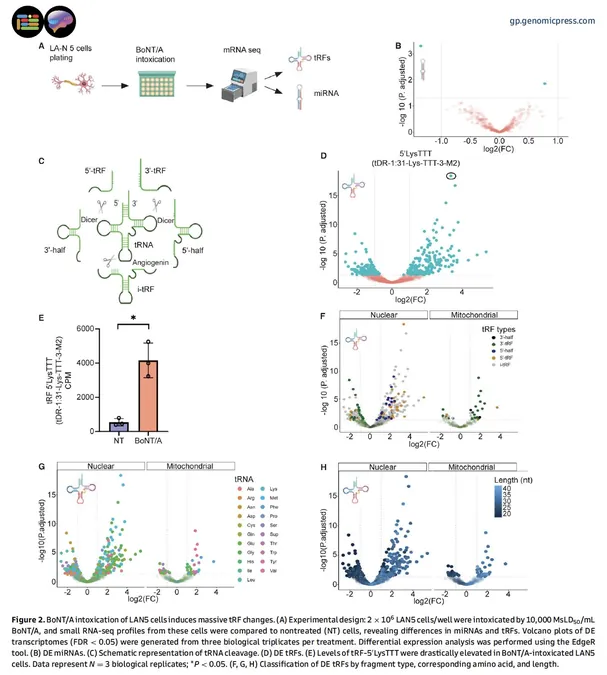
Unlocking the Secrets: How Neurons Outsmart the Deadly Botulinum Toxin
2025-05-20
Author: Rajesh
Revolutionary Findings on Botulinum Neurotoxin Type A
In a groundbreaking study, scientists have unveiled a surprising mechanism that allows neurons to withstand exposure to botulinum neurotoxin type A (BoNT/A), a toxin notorious for paralyzing muscles. Led by Dr. Hermona Soreq from The Hebrew University of Jerusalem, this research could transform our understanding of both medical treatments and cosmetic uses of this potent toxin.
The Dual Nature of Botulinum Toxins
Considered the most lethal biological toxin known, with an astonishing lethal dose of just 1 ng/kg, botulinum toxins can lead to devastating paralysis. Yet, they are also used widely in medicine and cosmetics. This paradox raises a crucial question: how do neurons survive such a powerful toxin?
Dr. Soreq points out, "Though BoNT/A causes paralysis without killing neurons—unlike other serotypes—how it allows for neuronal survival has remained largely unexplained until now."
The Role of Small RNAs
Utilizing cutting-edge genomic technology, the researchers examined molecular changes in human neuroblastoma cells subjected to BoNT/A. They discovered unexpected shifts in small RNA molecules, particularly transfer RNA fragments (tRFs), revealing that neurons accumulate specific tRFs following exposure to the toxin.
Dr. Arik Monash, the study's lead author, noted, "The massive increase in tRFs fronted minimal microRNA changes, suggesting that tRFs are pivotal players in the response to BoNT/A poisoning."
The Protective Power of tRFs
The research revealed that these 5'LysTTT tRFs actively support neuronal survival by blocking potential triggers for ferroptosis, a form of programmed cell death. By interacting with crucial proteins and RNA molecules, these tRFs allow neurons to remain functional despite the toxin's detrimental effects.
This discovery portrays tRFs as the cellular lifeguards of the nervous system, maintaining neuron viability amidst toxic threats.
Inside the Intriguing Mechanism of Defense
A fascinating discovery showed that around 20% of the accumulated tRFs shared a unique 11-nucleotide sequence, indicating a coordinated cellular defense mechanism conserved across species. Dr. Joseph Tam, co-senior author, emphasized its evolutionary significance, stating, "This shared motif highlights a fundamental protective strategy against intoxication."
Beyond Aesthetic Uses: Therapeutic Potential
Although BoNT/A is famously used for cosmetic enhancements, it also treats multiple medical issues such as dystonia and excessive sweating. Dr. Osnat Rosen, another co-senior author, notes that understanding the molecular underpinnings of BoNT/A could lead to better treatment options, tailored to enhance efficacy and duration.
Could tweaking these tRF pathways lead to personalized treatment regimens? This area of exploration holds immense promise for pharmaceutical innovation.
Future Directions: Expanding Therapeutic Horizons
The research opens new avenues in the quest for therapies aimed at protecting neurons from conditions like neurodegenerative diseases or traumatic brain injuries. Dr. Soreq and her team are now probing whether similar protective mechanisms exist in broader contexts requiring neuronal preservation.
"Our findings not only deepen our understanding of botulinum toxin's effects but also highlight crucial cellular survival strategies that could pave the way for revolutionary neurological treatments," concludes Dr. Soreq.



 Brasil (PT)
Brasil (PT)
 Canada (EN)
Canada (EN)
 Chile (ES)
Chile (ES)
 Česko (CS)
Česko (CS)
 대한민국 (KO)
대한민국 (KO)
 España (ES)
España (ES)
 France (FR)
France (FR)
 Hong Kong (EN)
Hong Kong (EN)
 Italia (IT)
Italia (IT)
 日本 (JA)
日本 (JA)
 Magyarország (HU)
Magyarország (HU)
 Norge (NO)
Norge (NO)
 Polska (PL)
Polska (PL)
 Schweiz (DE)
Schweiz (DE)
 Singapore (EN)
Singapore (EN)
 Sverige (SV)
Sverige (SV)
 Suomi (FI)
Suomi (FI)
 Türkiye (TR)
Türkiye (TR)
 الإمارات العربية المتحدة (AR)
الإمارات العربية المتحدة (AR)